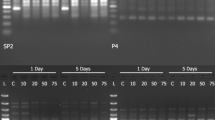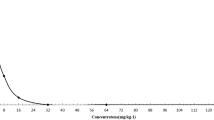Abstract
The effect of argemone oil on hsp70expression and tissue damage was investigated by studying β-galactosidase activity, Western blotting and hybridization, and trypan blue staining in the larval tissues of transgenic Drosophila melanogaster(hsp70-lacZ)Bg 9. Different concentrations of argemone oil were mixed with food and third-instar larvae were allowed to feed on them for different time intervals (2, 4, 24, and 48 h). Argemone oil was found to induce hsp70even in the lowest concentration of the adulterant while maximum tissue damage was observed in the higher two treatment groups. Malpighian tubules and midgut tissue reflected maximum damage as evidenced by both high β-galactosidase activity and trypan blue staining in these tissues. A prior temperature shock treatment to the larvae was enough to protect the larvae from argemone oil-induced tissue damage as evidenced by little or no trypan blue staining. The present study suggests the cytotoxic potential of argemone oil and further strengthens the evidence for the use of hsp70as a biomarker in risk assessment.
Similar content being viewed by others
References
Craig E, Boorstein W, Park HO, Stone D, Nicolet C.Complex regulation of three heat inducible hsp70 related genes in Saccharomyces cerevisiae.In: Pardue ML, Feramisco JR, Lindquist S, eds.Stress-induced proteins.New York: Alan R Liss; 1989:55-61
Das M, Khanna SK.Clinicoepidemiological, toxicological and safety evaluation studies on argemone oil.Crit Rev Toxicol. 1997;27:273-97.
Di Domenico BJ, Bugaisky GE, Lindquist S.The heat shock response is self-regulated at both the transcriptional and post-transcriptional levels.Cell.1982:31:593-603.
Hightower LE.Heat shock, stress proteins, chaperones and proteotoxicity.Cell.1991:66:191-200.
Kar Chowdhuri D, Saxena DK, Viswanathan PN.Effect of hexachlorohexane (HCH), its isomers and metabolites on Hsp70 expression in transgenic Drosophila melanogaster.Pesticide Biochem Physiol. 1999:63:15-25.
Kar Chowdhuri D, Nazir A, Saxena DK.Effect of three chlorinated pesticides on hsrw stress gene expression in transgenic Drosophila melanogaster.J Biochem Mol Toxicol. 2001:15:173-86.
Krebs RA, Feder ME.Tissue specific variation in hsp70 expression and thermal damage in Drosophila melanogasterlarvae.J Exp Biol. 1997:200:2007-15.
Laemmli UK.Cleavage of structural proteins during the assembly of the head of bacteriophage T4.Nature.1970; 227:680-82.
Lakhotia SC, Mukherjee T.Specific activation of puff 93D of Drosophila melanogasterby benzamide and the effect of benzamide on the heat shock inducing puffing activity.Chromosoma.1980;81:125-37.
Lakhotia SC, Singh AK.A novel set of heat shock polypeptides in Malpighian tubules of Drosophila melanogaster.J Genet. 1989:68:129-38.
Lindquist S.Autoregulation of the heat shock respose.In: llan J, ed.Translational regulation of gene expression 2.New York: Plenum Press; 1983:279-320.
Lindquist S, Craig EA.The heat shock proteins.Annu Rev Genet. 1988:22:631-77.
Lis JT, Simon JA, Sutton CA.New heat shock puffs and β-galactosidase activity resulting from transformation of Drosophilawith an hsp70-lacZhybrid gene.Cell.1983:35:403-13.
Margulis BA, Nacharov PV, Tsvetkova OI, Welsh M, Kinev AV.The characterization and use of different antibodies against the hsp70 major heat shock protein family for the development of an immunoassay.Electrophoresis.1991:12:670-7.
Nover L, Scharf KD.Heat shock proteins.In: Nover L, ed.Heat shock response.Boca Raton, FL: CRC Press; 1991: 41-128.
O'Kane CJ, Gehring WJ.Detection in situ of genomic regulatory elements in Drosophila.Proc Nati Acad Sci USA.1987; 84:9123-7.
Parkar CS, Topol J.DrosophilaRNA polymerase II transcrip-tion factor binds to the regulatory site of an hsp70gene.Cell.1984:37:273-83.
Pitts BJR, Meyerson LR.Inhibition ofNa+K+ATPase activity and ouabain binding ofsanguinarine.Drug Dev Res. 1981; 1:43-50.
Ryan JA, Hightower LE.Stress proteins as molecular biomarkers for environmental toxicology.In: Feige U, Morimoto Rl, Yahura I, Polla B, eds.Stress inducible cellular responses.Basel: BirkhauserVerlag; 1996:411-24.
Sambrook J, Fritsch EF, Maniatis T, eds.Molecular cloning, a laboratory manual.Cold Spring Harbor: Cold Spring Harbor Laboratory Press; 1989:18.47-75.
Sanders BM.Stress proteins in aquatic organisms: An environmental perspective.Crit RevToxicol. 1993:23:49-75.
Sanyal PK.Argemone and mustard seeds.Indian Med Gaz. 1950:85:498-504.
Schlesinger MJ.Heat shock proteins: the search for functions.J Cell Biol. 1986:103:321-5.
Singh BN, Lakhotia SC.The non-induction of HSP70 in heat shocked Malpighian tubules of Drosophilalarvae is not due to constitutive presence of HSP70 or HSC70.Curr Sci. 1995:69:178-82.
Stone DE, Craig EA.Self regulation of 70 kilo dalton heat shock proteins in Saccharomyces cerefisiae.Mol Cell Biol. 1990:10:1622-32.
Straub KD, Carver P.Sanguinarine inhibitor of Na+,K+dependent ATPase.Biochem Biophys Res Commun. 1975; 62:913-22.
Stringham EG, Candido EPM.Transgenic hsp70-lacZstrains of the soil nematode Caenorhabditis elegansas biological monitors of environmental stress.Environ Toxicol Chem. 1994:13:1211-20.
Upreti KK, Das M, Kumar A, Singh GB, Khanna SK.Biochemical toxicity of argemone oil.Short term oral feeding response in rats.Toxicology.1989:58:285-98.
Upreti KK, Das M, Khanna SK.Biochemical toxicity of argemone oil.Effect on hepatic cytochrome P-450 and xenobiotic metabolizing enzymes.J Appi Toxicol. 1991a; 11:203-10.
Upreti KK, Das M, Khanna SK.Role of antioxidants and scavengers on argemone oil induced toxicity.Arch Environ ContamToxicol. 1991b;20:531-7.
Velazquez JM, Lindquist S.hsp70: nuclear concentration during environmental stress and cytoplasmic storage during recovery.Cell.1984:36:655-62.
Voellmy R.Sensing stress and responding to stress.In: Feige U, Morimoto Rl, Yahura I, Polla B, eds.Stress inducible cellular response.Basel: BirkhauserVerlag; 1996:121-37.
Welch WJ.How cells respond to stress.Sci Am. 1993:34-41.
Wilkinson CF, Brattsten.Microsomal drug metabolizing enzymes in insects.Drug Metab Rev. 1972:1:153-228.
Author information
Authors and Affiliations
Rights and permissions
About this article
Cite this article
Mukhopadhyay, I., Nazir, A., Mahmood, K. et al. Toxicity of argemone oil: Effect on hsp70expression and tissue damage in transgenic Drosophila melanogaster(hsp70-lacZ) Bg 9 . Cell Biol Toxicol 18, 1–11 (2002). https://doi.org/10.1023/A:1014433711554
Issue Date:
DOI: https://doi.org/10.1023/A:1014433711554




